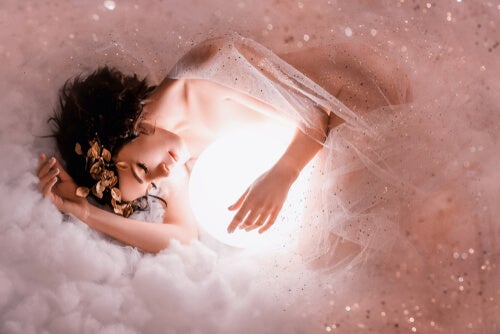Dreams accompany the nightly rest cycles of all of us. In fact, it’s estimated that all people have between four and six dreams a night, although the amount varies according to age, personality, level of tiredness, experiences of the day, and, of course, brain activity patterns.
Sleep phases are divided into two types: the rapid eye movement (REM) phase and the non-rapid eye movement (NREM) phase. We alternate between these phases several times a night and can manifest dream experiences in any of them. Here are the main types of dreams, according to scientists.
Main types of dreams
It was Revonsuo (2000) who first suggested that dreams have an evolutionary role. He claimed that we dream to simulate threatening events that we might potentially experience in reality.
This would explain why many types of dreams are organized, selective, and even repetitive. We’re going to talk about seven types of dreams that you’ll probably recognize.
1. Recurring dreams
These are the types of dreams in which the dream experience has a repetitive story or plot. Experts support Revonsuo’s thesis that these dreams are a simulation of threats and prepare us for when we have to face them in our day-to-day life.
This is why most of the experiences of this type revolve around love conflicts, being persecuted, and being in danger, among others. You might find you have these dreams several times a month, and they can even last for years. They may have unpleasant undertones to the point of becoming nightmarish.
2. Lucid dreams
Lucid dreams are those experiences in which you’re aware that you’re dreaming. Evidence indicates that it’s a skill that can be learned, although it can also be developed in isolation.
Experts classify these dreams as a hybrid state between wakefulness and conventional dreaming, one that also produces changes in electrophysiology.
3. Precognitive dreams
These are experiences in which you’re able to see a situation in the future. They’re known as premonitory or prophetic dreams. They’ve aroused interest in almost all civilizations. According to researchers, these dreams are more vivid, clear, and emotionally intense in contrast to conventional dreams.
However, the nature of these dreams is far from paranormal. Researchers claim that dreams of death are the most common. Illness, infidelity, success, and failure are also common themes. They don’t relate to the paranormal or any kind of paranormal ability.
4. False awakenings
False awakenings are those types of dreams in which you believe that you’ve woken up, but you’re really still dreaming. They often occur alongside lucid dreams. In fact, evidence suggests that up to 79 percent of lucid dreamers develop them frequently (monthly or annually).
Most of these experiences revolve around the habits that you perform after waking up. For example, going to the bathroom, making your bed, getting dressed, and eating. At some point in the dream, there’s a gap or an alteration of dream reality that suggests that the dream hasn’t yet ended.
5. Vivid dreams
Vivid dreams are those that you remember immediately upon waking. As we mentioned earlier, you’ll probably have between four and six dreams a night. However, you only remember the last dream, which is known as a vivid dream.
You generally remember these experiences because you wake up during REM sleep. If you wake up in the middle of the night, you might remember the content of the story and then remember it again in a completely different way when you wake up a couple of hours later.
Vivid dreams are also considered those that develop with greater intensity than normal.
6. Nightmares
Nightmares are probably the most well-known type of dream. They’re about unpleasant, uncomfortable, or disturbing experiences. Experts distinguish between nightmares and bad dreams, based on their nature, intensity, and degree of disturbance.
Following Revonsuo’s thesis, nightmares are another manifestation of a potentially dangerous simulation, only this time taken to the extreme. People with anxiety disorders, specific phobias, post-traumatic stress disorder, and problems in their daily lives are prone to developing these kinds of dreams.

7. Night terrors
Night terrors are considered a type of sleep disorder in which you wake up terrified, anxious, and stressed. You may or may not remember the dream itself. These are more common in children than in adults and often require treatment because they’re repetitive and often affect the dreamer’s life and those around them.
Of course, there are other types of dreams, such as daydreams, healing dreams, symbolic dreams, creative dreams, shared dreams, and visitation dreams. Detailed dreams are the most frequent, to the point that most people experience them at least once in their life.
Finally, keep in mind that the use of certain medications, psychological disorders, and circadian rhythm disturbances can affect your dreams.
If you think that the nature or content of your dreams is disturbing you more than necessary, don’t hesitate to seek professional help.
The post Seven Types of Dreams appeared first on Exploring your mind.



















Comments